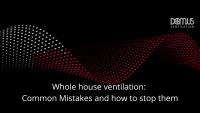 Add My Company
Add My Company
Sign In

Whole House Ventilation: Common mistakes and how to avoid them
By
Paul Williams, Domus Ventilation Product Manager
Domus Ventilation has been in the business for well over 30 years and, as you might expect, has been witness to a lot of changes over the decades, mostly driven by Building Regulations. We have moved from simple mechanical extract fans to whole-house ventilation, frequently with heat recovery. Ventilation has become more complex but also more important as our homes are built to greater air tightness standards in a drive for energy efficiency, and as we begin to realise the impact of indoor air quality on our health and well-being.
Of course, the more complex ventilation systems become, the more opportunity for errors to creep in. Here, we identify the four most common mistakes we regularly see when it comes to whole-house ventilation systems. Taking the time to understand and avoid them now, will save you a whole lot of time and expense further down the line!
Mistake 1: Using the wrong size MVHR unit
Mechanical Ventilation with Heat Recovery (MVHR) systems, such as our own HRXE range, are becoming ever more popular, with their combination of supply and extract ventilation in one system. Using a heat exchanger, up to 95% of the heat is typically lost in waste, stale air is efficiently recovered and used to temper the fresh air drawn into the building, which is then filtered and distributed within the home.
MVHR units come in different sizes to meet different-sized properties. Choose the wrong MVHR size and you run into difficulties: either it’s too big and therefore not energy efficient, or it’s too small and not going to deliver the ventilation required under Building Regulations, but will deliver excess noise as the fan within the unit works overtime to meet demand.
Incorrect unit specification often results from a failure to take into account the ductwork; where it is going to run and how much resistance is going to be in that ducting system. This is frequently because the ducting drawings have yet to be produced. As a result, smaller, less powerful MVHR units can be incorrectly specified. The key here is to ensure the ductwork drawing is done prior to unit specification and prior to other services, such as gas and water pipes, going in as otherwise you will need to add more duct work to get around these obstacles. Domus Ventilation offers a free drawing service for our customers, so this issue can be entirely – and easily! – avoided.
Ultimately, selecting an MVHR unit that is too small for the property will mean it won’t be compliant with latest Building Regulations and it won’t get signed off. This is an expensive mistake to make as the only real option is to replace the MVHR with a larger unit and hope there is the space for it. Replacing the ductwork with a larger profile alternative is certainly not an option as it’s already behind ceilings and walls.
Mistake 2: Not following the ventilation drawing on site
Even if you have the best ducting drawing for that building, if it’s not adhered to on site the entire ventilation system can be compromised and will be noisy. Sometimes installers will try to make the duct runs simpler, to save time and money, but it’s a false economy if you have to rip out the system at your expense as it doesn’t comply with Building Regulations.
The other red flag here is the replacement of rigid ducting with flexible duct work, which is mostly seen at final connections or around obstructions such as steel beams. Flexible duct causes a lot more air resistance and can be crushed easily. Other items that cause airflow resistance include using the wrong size air bricks and incorrect size air valves.
Mistake 3: Inadequate ducting insulation
Another key issue relating to ducting is the incorrect use – or total absence – of ducting insulation.
Ducting insulation is required under Building Regulations where the ducting passes through unheated areas and voids, such as loft spaces. The minimum duct insulation standard is the equivalent of at least 25mm of a material having a thermal conductivity of ≤0.04W/(m.K).
Specialist duct insulation, such as Domus Thermal, is essential to meet this requirement. A common mistake that is made is using insufficient insulation, using standard building insulation materials that are unsuitable or not using any insulation at all. Furthermore, we often see insulation missing from the intake and the exhaust.
The problem with poor insulation is that condensation forms, which drops down onto the ceiling and becomes an ugly visible stain. In the worst cases, this can lead to mould which is not only unsightly but can be hazardous to health.
Mistake 4: Incorrect MVHR system commissioning
Commissioning an MVHR system accurately is one of the most vital parts of getting the ventilation system signed off correctly. Any mistakes at the commissioning stage will result in over or under ventilating, and all the work that has gone into designing and installing the system correctly will be compromised.
There are two pitfalls to be avoided when it comes to commissioning.
When setting an MVHR unit up to be commissioned, the air valves in wet rooms and the kitchen need to be opened to get the required airflow rate. The airflow is measured using an anemometer, but that device needs to be the appropriate one for this particular task; it should be a calibrated powered hood anemometer that meets the ±5% accuracy required by Approved Document F1 (2022). Using a poor quality anemometer, or one that hasn’t been recently calibrated, will provide incorrect readings, causing the system to either over or under ventilate. This mostly occurs when engineers who are not BPEC/NICEIC qualified are used to undertake the commissioning.
The second problem area is when it comes to adjusting the potentiometers on the front of the MVHR unit need to ensure the correct trickle and boost rate. In apartment blocks, it’s tempting to assume that each apartment of the same size will require the same setting. However, the commissioning engineer can’t see ‘behind the scenes’; the ductwork may be run slightly different in the next apartment, for example, which will mean the settings need to be different.
Under changes to Building Regulations ‘Ventilation: Approved Document F’ which came into force in 2022, a new style commissioning sheet featuring a compliance report and photographic evidence must be provided to Building Control Bodies and the building owner. This should help to improve commissioning and ensure every individual apartment is tested and the MVHR system adjusted accordingly.
Domus Ventilation is a manufacturer of market-leading ventilation systems that save energy and improve indoor air quality.
www.domusventilation.co.uk
vent.info@domusventilation.co.uk
For more information on Whole House Ventilation: Common mistakes and how to avoid them talk to Domus Ventilation Ltd
Enquire Now
More News
List your company on FindTheNeedle.
